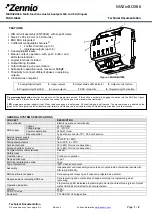MCF52110 ColdFire® Integrated Microcontroller Reference Manual, Rev. 1
Freescale Semiconductor
25-1
Preliminary
Chapter 25
Analog-to-Digital Converter (ADC)
25.1
Introduction
The analog-to-digital converter (ADC) consists of two separate and complete ADCs, each with their own
sample and hold circuits. The converters share a common voltage reference and common digital control
module.
25.2
Features
The ADC’s characteristics include the following:
•
12-bit resolution
•
Maximum ADC clock frequency of 5.0 MHz, 200 ns period
•
Sampling rate up to 1.66 million samples per second
1
•
Single conversion time of 8.5 ADC clock cycles (8.5
×
200 ns = 1.7
μ
s)
•
Additional conversion time of 6 ADC clock cycles (6
×
200 ns = 1.2
μ
s)
•
Eight conversions in 26.5 ADC clocks (26.5
×
200 ns = 5.3
μ
s) using simultaneous mode
•
Ability to simultaneously sample and hold 2 inputs
•
Ability to sequentially scan and store up to 8 measurements
•
Internal multiplex to select two of 8 inputs
•
Power savings modes allow automatic shutdown/startup of all or part of ADC
•
Those inputs not selected tolerate injected/sourced current without affecting ADC performance,
supporting operation in noisy industrial environments.
•
Optional interrupts at the end of a scan, if an out-of-range limit is exceeded (high or low), or at zero
crossing
•
Optional sample correction by subtracting a pre-programmed offset value
•
Signed or unsigned result
•
Single ended or differential inputs for all input pins with support for an arbitrary mix of input types
1. In loop mode, the time between each conversion is 6 ADC clock cycles (1.2
μ
s at 5.0 MHz). Using simultaneous conversion,
two samples are captured in 1.2
μ
s, providing an overall sample rate of 1.66 million samples per second.


















